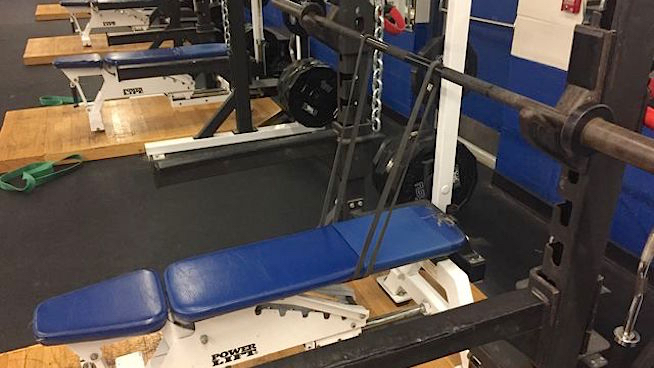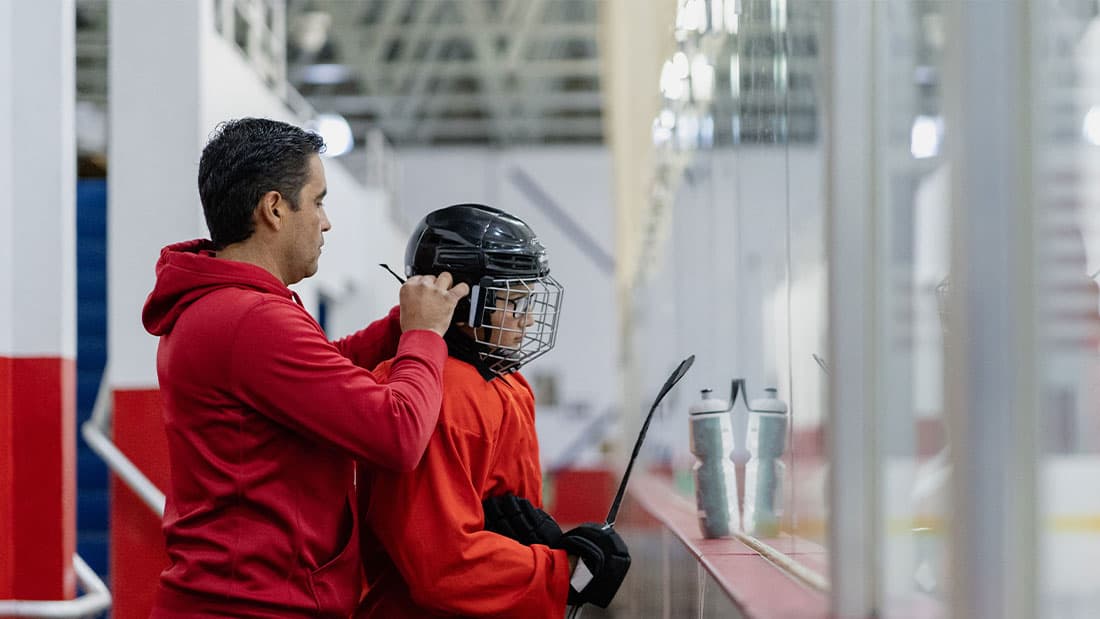How to Use Resistance Bands to Supercharge Your Workouts
Experienced athletes can reach plateaus where they feel as if they can’t proceed to the next level of strength and power. Even athletes who aren’t plateauing can hit a wall where their training feels boring and monotonous.
The answer to such issues? Bands. Adding bands to your training program is inexpensive, effective and fun. Bands offer “accommodating resistance,” which means the most added resistance is at the portion of the lift where you should be strongest and the least added resistance is at the portion where explosiveness is most important. This makes every portion of the exercise challenging. Bands can help you smash through plateaus and increase maximal strength, explosive power, maximal power output, muscle mass and stability.
In this article, I’ll outline three athlete training staples that can be supercharged with the addition of bands.
1. Improve Pushing Power With the Barbell Band Bench Press
Once you get past the “sticking point” with a standard Bench Press, the rest of the movement isn’t much of a challenge. That changes with Barbell Band Bench Press, as the added resistance from the band only increases the farther the bar gets away from your body. I recommend setting up for this exercise as shown in the photo above. The added resistance of the bands will lower the amount of weight you can put on the bar, so experiment until you find the right load. As you prepare to Bench Press, slide your arms through the bands and grab the bar (imagine the bands being like back pack straps).
The exercise is as simple as slowly lowering the bar under control and explosively pressing it as you would on a normal Bench Press. In terms of tempo, I like to use a tactic where each rep takes one second longer than the total number of reps in a set. If you’re performing 6 reps, each rep should take 7 seconds, or if you’re performing 2 reps, it should take no more than 3 seconds. Bands are great for building muscle and also take away a lot of the eccentric stress of barbell exercises, making them a fantastic in-season training option to keep your body fresh.
In terms of sets and reps, use a maximum of 6 reps per set (power will be lost beyond this point) and 3-6 sets. The more sets you do, the more rest you’ll need.
2. Improve Lower-Body Power With the Barbell Band Front Squat
The same area for improvement present in the Bench Press is present in the Squat: Once you get through the “sticking point,” the rest of the exercise is quite easy by comparison. Adding bands directly addresses this issue.
I recommend setting up for the Barbell Band Front Squat as shown in the photo above. That’s a 2.5-inch band attached on the end of the barbell with a clip placed behind the band and a clip behind the plate weight. A dumbbell as heavy as possible (I used 90s in the picture) is placed on the floor and a plate is position to anchor it in place.
Make sure the band length (and thus band tension) is the same on both sides of the barbell. To perform this exercise, simply utilize proper Front Squat technique. Lower the bar with control until your thighs are parallel to the floor. Explosively drive through your heels to stand up and power through the accommodating resistance of the band all the way to the top of the movement. Utilize the same tempo as the Barbell Band Bench Press with each rep taking 1 second longer than the total numbers of reps in the set. So If you’re performing 6 reps, one rep should take 7 seconds, or if you’re performing 2 reps, one rep should take no more than 3 seconds. I highly recommend using bands in-season as squatting is an exercise that produces a high amount of athletic development, but most kids do not want to squat in-season.
3. Build Awesome Pulling Power With the Band Pull-Up ‘Satan Complex’

Photo via Athletic Preparation YouTube
This is a seriously challenging complex. If you can’t complete 10 Pull-Ups with perfect form in one set, do not attempt this. Focus on getting stronger in the movement, and once you are able to complete 10 Pull-Ups in a set, you can add this complex to your training regimen.
This complex, nicknamed the “Satan Complex,” is meant to build muscle in the upper-body pulling muscles. Ideally, the Satan Complex will be completed using sets of 6. It begins with 1 set of 6 Weighted Pull-Ups, then a set of 6 Bodyweight Pull-Ups, and finally a set of six Band-Assisted Pull-Ups. To perform Band-Assisted Pull-Ups, simply loop a band around the bar like you see in the above photo and then loop the other side around your foot or thigh. You only need to perform 2 total sets of this complex during a training session, as the volume is quite high. I especially like this complex for non-overhead sports and contact sports such as football, as it’s fantastic for maintaining upper-body muscle mass and strength during the season.
We use the Perform Better superbands, and each color and size combination is associated with a certain amount of resistance. This ranges from just 5-15 pounds of resistance on the 1/2-inch Orange band to 225-300 pounds on the 4-inch Black band.
READ MORE:
- Why Resistance Band Workouts Are Perfect for Young Athletes
- 15 Awesome Resistance Band Exercises for Strength
- The Many Benefits of Resistance Band Training
RECOMMENDED FOR YOU
MOST POPULAR
How to Use Resistance Bands to Supercharge Your Workouts
Experienced athletes can reach plateaus where they feel as if they can’t proceed to the next level of strength and power. Even athletes who aren’t plateauing can hit a wall where their training feels boring and monotonous.
The answer to such issues? Bands. Adding bands to your training program is inexpensive, effective and fun. Bands offer “accommodating resistance,” which means the most added resistance is at the portion of the lift where you should be strongest and the least added resistance is at the portion where explosiveness is most important. This makes every portion of the exercise challenging. Bands can help you smash through plateaus and increase maximal strength, explosive power, maximal power output, muscle mass and stability.
In this article, I’ll outline three athlete training staples that can be supercharged with the addition of bands.
1. Improve Pushing Power With the Barbell Band Bench Press
Once you get past the “sticking point” with a standard Bench Press, the rest of the movement isn’t much of a challenge. That changes with Barbell Band Bench Press, as the added resistance from the band only increases the farther the bar gets away from your body. I recommend setting up for this exercise as shown in the photo above. The added resistance of the bands will lower the amount of weight you can put on the bar, so experiment until you find the right load. As you prepare to Bench Press, slide your arms through the bands and grab the bar (imagine the bands being like back pack straps).
The exercise is as simple as slowly lowering the bar under control and explosively pressing it as you would on a normal Bench Press. In terms of tempo, I like to use a tactic where each rep takes one second longer than the total number of reps in a set. If you’re performing 6 reps, each rep should take 7 seconds, or if you’re performing 2 reps, it should take no more than 3 seconds. Bands are great for building muscle and also take away a lot of the eccentric stress of barbell exercises, making them a fantastic in-season training option to keep your body fresh.
In terms of sets and reps, use a maximum of 6 reps per set (power will be lost beyond this point) and 3-6 sets. The more sets you do, the more rest you’ll need.
2. Improve Lower-Body Power With the Barbell Band Front Squat
The same area for improvement present in the Bench Press is present in the Squat: Once you get through the “sticking point,” the rest of the exercise is quite easy by comparison. Adding bands directly addresses this issue.
I recommend setting up for the Barbell Band Front Squat as shown in the photo above. That’s a 2.5-inch band attached on the end of the barbell with a clip placed behind the band and a clip behind the plate weight. A dumbbell as heavy as possible (I used 90s in the picture) is placed on the floor and a plate is position to anchor it in place.
Make sure the band length (and thus band tension) is the same on both sides of the barbell. To perform this exercise, simply utilize proper Front Squat technique. Lower the bar with control until your thighs are parallel to the floor. Explosively drive through your heels to stand up and power through the accommodating resistance of the band all the way to the top of the movement. Utilize the same tempo as the Barbell Band Bench Press with each rep taking 1 second longer than the total numbers of reps in the set. So If you’re performing 6 reps, one rep should take 7 seconds, or if you’re performing 2 reps, one rep should take no more than 3 seconds. I highly recommend using bands in-season as squatting is an exercise that produces a high amount of athletic development, but most kids do not want to squat in-season.
3. Build Awesome Pulling Power With the Band Pull-Up ‘Satan Complex’

Photo via Athletic Preparation YouTube
This is a seriously challenging complex. If you can’t complete 10 Pull-Ups with perfect form in one set, do not attempt this. Focus on getting stronger in the movement, and once you are able to complete 10 Pull-Ups in a set, you can add this complex to your training regimen.
This complex, nicknamed the “Satan Complex,” is meant to build muscle in the upper-body pulling muscles. Ideally, the Satan Complex will be completed using sets of 6. It begins with 1 set of 6 Weighted Pull-Ups, then a set of 6 Bodyweight Pull-Ups, and finally a set of six Band-Assisted Pull-Ups. To perform Band-Assisted Pull-Ups, simply loop a band around the bar like you see in the above photo and then loop the other side around your foot or thigh. You only need to perform 2 total sets of this complex during a training session, as the volume is quite high. I especially like this complex for non-overhead sports and contact sports such as football, as it’s fantastic for maintaining upper-body muscle mass and strength during the season.
We use the Perform Better superbands, and each color and size combination is associated with a certain amount of resistance. This ranges from just 5-15 pounds of resistance on the 1/2-inch Orange band to 225-300 pounds on the 4-inch Black band.
READ MORE:
- Why Resistance Band Workouts Are Perfect for Young Athletes
- 15 Awesome Resistance Band Exercises for Strength
- The Many Benefits of Resistance Band Training












